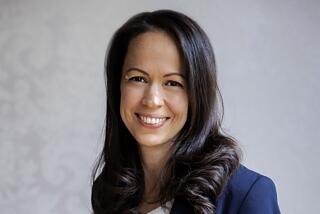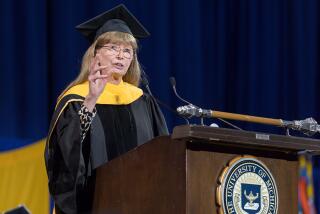Robert Noyce, Computer Age Pioneer, Dies
- Share via
Robert N. Noyce, a modern-day Thomas Edison who helped usher in the Computer Age by co-inventing the semiconductor and later led an effort to restore America’s leadership in computer chips, died Sunday morning of a heart attack. He was 62.
The Silicon Valley pioneer was stricken at his home in Austin, Tex., and was rushed to Seton Medical Center, where he was pronounced dead minutes after his arrival, according to a hospital spokesman. Noyce, who exercised regularly but also was a chronic smoker, suffered the attack shortly after completing a morning swim at his home, according to a close family friend.
Noyce remained a prominent member of the electronics industry for more than 30 years after he and Jack Kilby, working independently, created the integrated circuit. That led to a dramatic increase in computer power by placing multiple transistors on a single silicon chip, and made possible a multitude of products ranging from pocket calculators to sophisticated missile and aircraft electronics systems.
At the time of his death, Noyce was the chairman of Sematech, a consortium of electronic firms and the federal government that was created to invigorate the domestic semiconductor industry. U.S. chip makers--including Intel Corp., which Noyce co-founded--have lost worldwide industry dominance to aggressive Japanese competitors.
Noyce’s death comes at a time when U.S. electronics industry officials worry that the Bush Administration may reduce federal funding for Sematech. While Noyce’s absence is not expected to lead to a management crisis at the consortium, his unquestioned stature and respect gave the venture added credibility and significance.
A three-member office of the chief executive, which Noyce created, will run Sematech until a new president is selected, a Sematech spokesman said. In April, Noyce had asked the consortium’s board of directors to begin searching for his eventual replacement.
“Bob Noyce made important contributions to the science of integrated circuits and his leadership of Sematech has pointed the way to a revitalized U.S. semiconductor industry,” said Michael J. Attardo, president of the general technology division of International Business Machines and that company’s representative on the Sematech board.
“The electronics industry lost a legendary figure today with Bob Noyce’s sudden death,” Intel Chairman Gordon E. Moore said in a statement. “Sematech is a good example of Bob’s character. Two years ago, the industry and the government urged him to take on leadership of Sematech. He answered the call out of a sense of responsibility to the nation, and met the challenge of getting the Sematech effort rolling.”
“Bob was an instrumental figure in creating what has become a $50-billion industry and semiconductors are the driving force behind a $500-billion electronics industry,” said Stan Victor, a spokesman for Texas Instruments. “He will be missed.”
Noyce was born Dec. 12, 1927, in Burlington, Iowa. He graduated from Grinnell College in Grinnell, Iowa, with bachelor’s degrees in physics and mathematics and membership in Phi Beta Kappa. Noyce earned his Ph.D. in physics from the Massachusetts Institute of Technology in 1953.
He became a researcher at Philco Corp., then moved to the Shockley Semiconductor Laboratory. He co-founded Fairchild Semiconductor Corp. in 1957, where he and Kilby, of Texas Instruments, separately invented the integrated circuit. In 1968, Noyce and longtime associate Moore founded Intel.
In 1988, Noyce was selected to head Sematech after initially putting himself out of the running for the position. “It finally dawned on me it was far too important for someone else to do,” he said after deciding to accept the post. “I had to do it myself.”
Noyce said it was essential to U.S. economic and military security for the industry to regain its worldwide leadership in semiconductors. He even urged that highly independent U.S. industry members adopt the cooperative methods of the Japanese.
The Austin-based consortium--which includes Intel, Texas Instruments and 12 other U.S. chip makers--has an annual budget of $200 million provided by the government and manufacturers. Noyce had established a three-member management team consisting of himself, chief operating officer Turner E. Hasty and chief administrative officer Peter H. Mills.
One possible successor to Noyce is Sanford Kane, a former IBM executive and Sematech co-founder who headed unsuccessful efforts last year to create another chip-making cooperative called U.S. Memories. Kane said Sunday that he has talked informally in recent months with the consortium’s board and with Noyce about taking over Noyce’s job.
While admitting that Noyce would be a difficult man to follow, Kane said he is interested in the challenge. “I feel up to the task,” he said. “I have no question that I have the capabilities, the right contacts and leadership skills to do the job.”
In addition to his Sematech duties, Noyce had remained as Intel’s vice chairman and was an active member of its board.
Noyce was awarded the National Medal of Technology by President Ronald Reagan in 1987 and the National Medal of Science from President Jimmy Carter in 1980. He was inducted into the National Inventors Hall of Fame in 1983 and elected to the U.S. Business Hall of Fame last year.
In February, Noyce and Kilby were presented the first Charles Stark Draper Award by President Bush. “Integrated circuits have enabled us to do the unimaginable,” Bush said at the awards ceremony: “Now, it is unimaginable to believe we could ever live without them. The microchip . . . helped America change the world.”
Noyce held 16 patents for semiconductor devices, methods and structures. He was a founding member and first president of the Semiconductor Industry Assn.
Noyce is survived by his wife, Ann Bowers, four children and 12 grandchildren.






